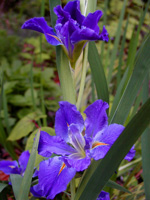Resource Library
Plant of the Week: Louisiana Hybrid Iris
The University of Arkansas System Division of Agriculture does not promote, support or recommend plants featured in "Plant of the Week." Please consult your local Extension office for plants suitable for your region.
Plant of the Week
Louisiana Iris Hybrids
Latin: Iris fulva, I. brevicaulis, I. giganticaerulea and I. nelsonii

A fine line exists between aggression and vigor when it comes to plants. I find myself appreciating vigorous plants that grow and spread in my garden, but I keep a wary eye on those that might take over. The Louisiana iris hybrids are on my watch list, for they are can prove to be vigorously aggressive.
Louisiana irises have been hybridized from four Mississippi Delta species: Iris fulva, I. brevicaulis, I. giganticaerulea and I. nelsonii. The first two extend their native range into the Delta region of Arkansas. In nature, these plants grow in sunny bogs in heavy soil.
The hybrids are a variable lot with flower colors ranging from whites to yellows and blues to a coppery red. Hybridization has increased the bloom size to as much as seven inches across but most are in the five inch range. The bloom scape usually contains four blooming positions with two flowers produced at each position.
Most Louisiana hybrids initiate their growth in the fall with 3- to 4-foot tall evergreen leaves that stand erect-like swords in the landscape. Though they are of southern heritage, they are quite cold hardy and can be grown wherever irises will grow. Depending on the hybrid, blooms appear from mid May until late June.
The vigor associated with the Louisiana irises is because of their wide-spreading rhizomes capable of 6 inches of growth in a single season. And, like all irises, these rhizomes branch and in a few years they can steam roll their neighbors.
Louisiana irises are newcomers to the garden world.
They were locally grown and admired in the lower Mississippi Delta region as wildflowers, but hybridizing was left to the bees. Then, beginning in the 1930s, a concerted effort was made to collect the wild species and naturally occurring hybrids from the wild. Controlled breeding began in 1941 when Ira Nelson made crosses at the University of Southwestern Louisiana. Today, this group of plants has become a southern staple, spawning its own society and a number of hobby breeders across the south.
Watering and Care Tips
Though these plants grow in boggy places in the wild, they thrive in normal garden conditions. Because they grow in heavy, clay soils, a little water will go a long ways. Like most garden perennials, an inch of water a week through rainfall or irrigation is sufficient. To bloom best and prevent stems from toppling, they should have at least six hours of sunlight.
My first experience with these plants was about a decade ago when I planted a blue and a coppery hybrid. Both were in full sun with the blue clone in good soil; the coppery one in clay that would make fine bricks.
In five years, the blue plant took over the entire bed while the coppery one stayed put but bloomed every season. In a salvage mission, I dug the blue plant up and banished it to my shade garden with some starts going into the ground and some into pots in my shady water garden. In the shade, they send up a few floppy spikes each spring but obviously want for sunlight. But shade has quelled its aggression and I like the spiky evergreen foliage in the water garden.
Picking a Planting Location
Be cautious in mixing these aggressive plants into a conventional perennial border. Instead, develop a bed devoted to just this group. Plant the clumps 24 to 30 inches apart and let them fight it out. If you want to maintain tight control of your plants and always know their names, divide every three years in early fall.
By: Gerald Klingaman, retired
Extension Horticulturist - Ornamentals
Extension News - June 16, 2006
The University of Arkansas System Division of Agriculture does not maintain lists of retail outlets where these plants can be purchased. Please check your local nursery or other retail outlets to ask about the availability of these plants for your growing area.